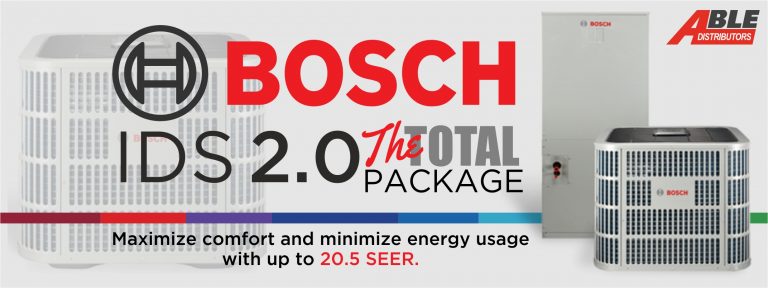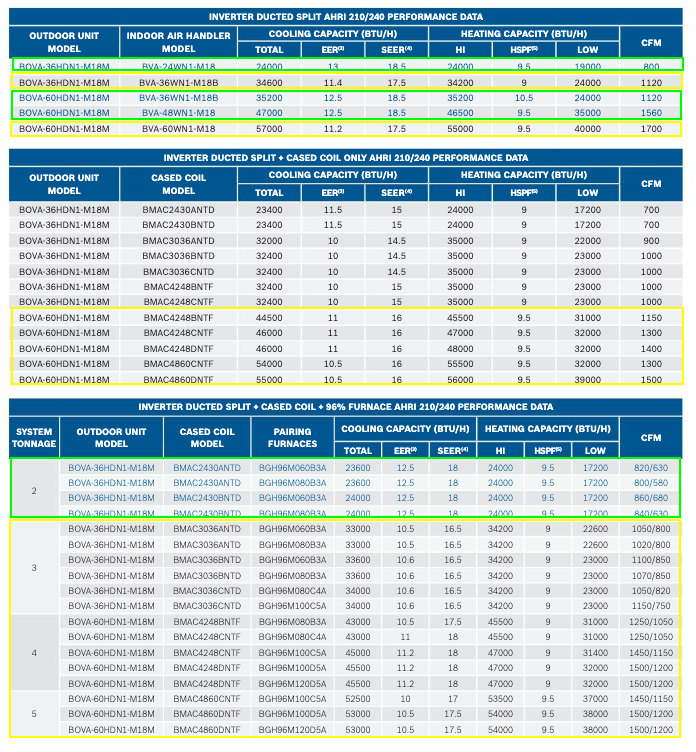Bosch IDS 2.0 | The Total Package

Last week, we touched on what kind of rebate value you can expect from a new Bosch IDS 2.0 system and before that we provided a flyer detailing the differences between the new generation and the original. Today, we are going to be taking a closer look at everything surrounding the Bosch IDS 2.0 system. Buckle in for a closer look at rebates and specs as well as a rundown of the applications where each of these systems shine.
Rebate Rundown
The main heat pump rebates available from ComEd are:
$450 – Above 18 SEER + 8.8 HSPF
$350 – Above 16 SEER + 8.6 HSPF
Both IDS 1.0 and IDS 2.0 can qualify for the larger rebate, but it a lot easier with a 2.0 system. Below are charts for lines. Anything inside a yellow box qualifies for $350 and everything in a green box qualifies for $450. If you are pairing with a Napoleon or Gibson furnace, please check with AHRI to verify rebate eligibility.
IDS 1.0 Chart
IDS 2.0 Chart
IDS 2.0 systems offer another $100 when you include a BVA air handler or ECM furnace, if the home didn’t already have an ECM blower. In addition to these credits, you can add another $75 if the homeowner adds a smart thermostat.
+$100 – Adding ECM
+$75 – Adding Smart Thermostat
That means, for a top-end 2.0 upgrade, your homeowner could be seeing $625 back on top of the monthly energy savings!
Specs Summary + Ideal Applications
When it comes to what the IDS 2.0 does better than its predecessor, there are three main values to look at:
- Outdoor Temperature Operation Range
- Maximum Lineset Length
- Efficiency
The SEER differences are pretty well fleshed out in the rebate section above, so we will be focusing on the lineset length and operational range. These might not seem like the sexiest upgrades at first blush, but they are very relevant to an application that is seen all across Chicago: condominiums. Specifically, high-rise units.
Thanks to the enhanced lineset length, a Bosch heat pump is now an option for many units that were simply too far away from the necessary condenser location. The IDS 2.0 system’s 150′ value is a full 50% higher than the already impressive 1.0.
The other major boon for high-rise applications is the low ambient functionality. The Bosch IDS 2.0 heat pump can provide heating in outdoor conditions down to -4°, which we definitely hit in Chicago. It can also provide cooling in outdoor temperatures as low as 15°. If you are in a high-rise condo with radiant heating, you might not have full control over the radiator output and even if you do, you probably do not have windows that open. The low ambient cooling of an IDS 2.0 system can help you stay comfortable in any conditions.
Download Bosch IDS 1.0 + IDS 2.0 Comparison Flyer
One area where the 1.0 still reigns supreme is in SDHV (small-duct high-velocity) systems. Currently, there are not approved matches for Bosch 2.0 condensers and Unico air handlers. However, the IDS 1.0 matches are still good to go. As a refresher they are:
- Bosch BOVA36 + Unico M3036
- Bosch BOVA60 + Unico M3642
The Bottom Line
In the simplest terms, Bosch’s IDS 1.0 product line is very good, the 2.0 is even better. If you are doing a standard single-family application and top-end efficiency isn’t a huge concern for the homeowner, the 1.0 is an amazing system. It is nearly silent, it’s still very efficient, and it has a great 10-year warranty. However, if your application is a bit trickier or your client is looking to maximize their rebate value and energy savings, the IDS 2.0 is the system for the job. Available now at all Able locations.

